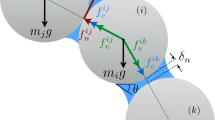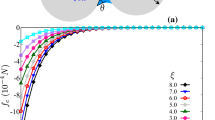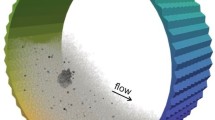Abstract
We investigate the impact dynamics of a single wet agglomerate composed of primary spherical particles impacting a flat plane by using three-dimensional discrete element method simulations. The primary particle is assumed to be rigid and interacted with its near-neighboring particles by introducing approximate analytical expressions of capillary cohesion forces and lubrication forces induced from the liquid in addition to their elastic and frictional interactions. The paper analyzes the mechanical strength, the deformation, and the connectivity of wet particle agglomerate during the impact as well as in its early-stage impact and the final-stage deposition. We show that the mechanical strength, deformation, and connectivity of granule strongly depend on the key parameters (the liquid–vapor surface tension, the liquid viscosity, and the impact speed of agglomerate). In particular, the early-stage strength and the height of wet agglomerate at its final-stage deposition nicely behave as a function of the Capillary–Stokes inertial number that combines the Capillary number and Stokes number, and the macroscopic strength of the agglomerate at its early-stage impact has the microscopic origin from the normal compressive forces between primary particles. These observations are consistent that represent the relationship between the rheological properties and the liquid properties and the impact conditions of wet granular materials.















Similar content being viewed by others
References
Nimmo J (2005) Aggregation|physical aspects. In: Hillel D (ed) Encyclopedia of soils in the environment. Elsevier, Oxford, pp 28–35
Sarkar J, Dubey D (2016) Failure regimes of single wet granular aggregate under shear. J Non-Newton Fluid Mech 234:236–248
Ennis BJ, Tardos G, Pfeffer R (1991) A microlevel-based characterization of granulation phenomena. Powder Technol 65(1):257–272
Rondet E, Delalonde M, Ruiz T, Desfoursb JP (2010) Fractal formation description of agglomeration in low shear mixer. Chem Eng J 164:376–382
Barkouti A, Rondet E, Delalonde M, Ruiz T (2012) Influence of physicochemical binder properties on agglomeration of wheat powder in couscous grain. J Food Eng 111:234–240
Nosrati A, Addai-Mensah J, Robinson DJ (2012) Drum agglomeration behavior of nickel laterite ore: effect of process variables. Hydrometallurgy 125–126:90–99
Chien SH, Carmona G, Prochnow LI, Austin ER (2003) Cadmium availability from granulated and bulk-blended phosphate-potassium fertilizers. J Environ Qual 32(5):1911–1914
Suresh P, Sreedhar I, Vaidhiswaran R, Venugopal A (2017) A comprehensive review on process and engineering aspects of pharmaceutical wet granulation. Chem Eng J 328:785–815
Lian G, Thornton C, Adams MJ (1998) Discrete particle simulation of agglomerate impact coalescence. Chem Eng Sci 53(19):3381–3391
Kafui K, Thornton C (2000) Numerical simulations of impact breakage of a spherical crystalline agglomerate. Powder Technol 109(1):113–132
Mishra B, Thornton C (2001) Impact breakage of particle agglomerates. Int J Miner Process 61(4):225–239
Thornton C, Ciomocos MT, Adams MJ (2004) Numerical simulations of diametrical compression tests on agglomerates. Powder Technol 140:258–267
Liu L, Kafui K, Thornton C (2010) Impact breakage of spherical, cuboidal and cylindrical agglomerates. Powder Technol 199(2):189–196
Vo T-T, Mutabaruka P, Nezamabadi S, Delenne J-Y, Izard E, Pellenq R, Radjai F (2018) Mechanical strength of wet particle agglomerates. Mech Res Commun 92:1–7
Khalilitehrani M, Olsson J, Rasmuson A, Daryosh F (2018) A regime map for the normal surface impact of wet and dry agglomerates. AIChE J 64(6):1975–1985
Vo T-T, Nezamabadi S, Mutabaruka P, Delenne J-Y, Izard E, Pellenq R, Radjai F (2019) Agglomeration of wet particles in dense granular flows. Eur Phys J E 42(9):127
Vo T-T, Mutabaruka P, Nezamabadi S, Delenne J-Y, Radjai F (2020) Evolution of wet agglomerates inside inertial shear flow of dry granular materials. Phys Rev E 101:032906
Tong Z, Yang R, Yu A, Adi S, Chan H (2009) Numerical modelling of the breakage of loose agglomerates of fine particles. Powder Technol 196(2):213–221
Vo TT (2019) Modeling the rheology of wet granular materials. Thesis, Université de Montpellier
Talu I, Tardos GI, Khan MI (2000) Computer simulation of wet granulation. Powder Technol 110:59–75
Iveson S, Beathe J, Page N (2002) The dynamic strength of partially saturated powder compacts: the effect of liquid properties. Powder Technol 127:149–161
Ghadiri M, Salman AD, Hounslow M, Hassanpour A, York DW (2011) Editorial: Special issue—agglomeration. Chem Eng Res Des 89(5):499
Nguyen D, Rasmuson A, Thalberg K, Niklasson Björn I (2015) A breakage and adhesion regime map for the normal impact of loose agglomerates with a spherical target. AIChE J 61(12):4059–4068
Rahmanian N, Ghadiri M (2013) Strength and structure of granules produced in continuous granulators. Powder Technol 233:227–233
Khalifa A, Breuer M (2020) Data-driven model for the breakage of dry monodisperse agglomerates by wall impact applicable for multiphase flow simulations. Powder Technol 376:241–253
Ning Z, Boerefijn R, Ghadiri M, Thornton C (1997) Distinct element simulation of impact breakage of lactose agglomerates. Adv Powder Technol 8(1):15–37
Thornton C, Ciomocos M, Adams M (1999) Numerical simulations of agglomerate impact breakage. Powder Technol 105(1):74–82
Liu L, Thornton C, Shaw SJ, Tadjouddine EM (2016) Discrete element modelling of agglomerate impact using autoadhesive elastic–plastic particles. Powder Technol 297:81–88
Deng X, Davé RN (2017) Breakage of fractal agglomerates. Chem Eng Sci 161:117–126
Vo T-T (2021) Scaling behavior of the tensile strength of viscocohesive granular aggregates. Phys Rev E 103:042902
Zhang L, Wu C-Y (2020) Discrete element analysis of normal elastic impact of wet particles. Powder Technol 362:628–634
Chen H, Liu W, Zheng Z, Li S (2021) Impact dynamics of wet agglomerates onto rigid surfaces. Powder Technol 379:296–306
Vo T-T, Nezamabadi S, Mutabaruka P, Delenne J-Y, Radjai F (2020) Additive rheology of complex granular flows. Nat Commun 11:1476
Radjai F, Topin V, Richefeu V, Voivret C, Delenne J-Y, Azéma E, El Youssoufi MS (2010) Force transmission in cohesive granular media. In: Goddard JD, Jenkins JT, Giovine P (eds) Mathematical modeling and physical instances of granular flows. AIP, Dabaka, pp 240–260
Bagnold RA (1954) Experiments on a gravity-free dispersion of large solid spheres in a Newtonian fluid under shear. Proc R Soc Lond 225:49–63
da Cruz F, Emam S, Prochnow M, Roux J-N, Chevoir F (2005) Rheophysics of dense granular materials: discrete simulation of plane shear flows. Phys Rev E 72:021309
Khalilitehrani M, Olsson J, Daryosh F, Rasmuson A (2019) The morphology of the deposited particles after a wet agglomerate normal surface impact. Powder Technol 345:796–803
Azéma E, Sánchez P, Scheeres DJ (2018) Scaling behavior of cohesive self-gravitating aggregates. Phys Rev E 98:030901
Vo T-T (2020) Erosion dynamics of wet particle agglomerates. Comput Part Mech 8:601–612
Trulsson M, Andreotti B, Claudin P (2012) Transition from the viscous to inertial regime in dense suspensions. Phys Rev Lett 109:118305
Amarsid L, Delenne J-Y, Mutabaruka P, Monerie Y, Perales F, Radjai F (2017) Viscoinertial regime of immersed granular flows. Phys Rev E 96:012901
Vo T-T (2020) Rheology and granular texture of viscoinertial simple shear flows. J Rheol 64(5):1133–1145
Radjai F, Dubois F (2011) Discrete-element modeling of granular materials. Wiley, New York
Richefeu V, ElYoussoufi S, Azéma E, Radjai F (2009) Force distribution in cohesive and non cohesive granular media. Powder Technol 190:258263
Matuttis H, Luding S, Herrmann H (2000) Discrete element simulations of dense packings and heaps made of spherical and non-spherical particles. Powder Technol 109(1):278–292
Lian G, Thornton C, Adams M (1993) A theoretical study of the liquid bridge forces between two rigid spherical bodies. J Colloid Interface Sci 161:138–147
Scheel M, Seemann R, Brinkmann M, Michiel MD, Sheppard A, Herminghaus S (2008) Liquid distribution and cohesion in wet granular assemblies beyond the capillary bridge regime. J Phys Condens Matter 20(49):494236
Delenne J-Y, Richefeu V, Radjai F. (2015) Liquid clustering and capillary pressure in granular media. J Fluid Mech 762:R5
Richefeu V, El Youssoufi MS, Radjaï F (2007) Shear strength of unsaturated soils: experiments, dem simulations, and micromechanical analysis. In: Theoretical and numerical unsaturated soil mechanics. Springer, Berlin Heidelberg, pp 83–91
Willett C, Adans M, Johnson S, Seville J (2000) Capillary bridges between two spherical bodies. Langmuir 16:9396–9405
Moreno-Atanasio R (2012) Energy dissipation in agglomerates during normal impact. Powder Technol 223:12–18 (Invited papers from delegates of Chemeca 2010: The 40th Annual Australasian Chemical Engineering Conference)
Cundall PA, Strack ODL (1979) A discrete numerical model for granular assemblies. Géotechnique 29(1):47–65
Allen MP, Tildesley DJ (1987) Computer simulation of liquids. Oxford University Press, Oxford
Luding S (1998) Collisions and contacts between two particles. In: Herrmann HJ, Hovi J-P, Luding S (eds) Physics of dry granular media—NATO ASI series E350. Kluwer Academic Publishers, Dordrecht, p 285
Thornton C (1999) Quasi-static shear deformation of a soft particle system. Powder Technol 109:179–191
Duran J, Reisinger A, de Gennes P (1999) Sands, powders, and grains: an introduction to the physics of granular materials, partially ordered systems. Springer, New York
Richefeu V, El Youssoufi M, Radjai F (2006) Shear strength properties of wet granular materials. Phys Rev E 73:051304
Pitois O, Moucheront P, Chateau X (2000) Liquid bridge between two moving spheres: an experimental study of viscosity effects. J Colloid Interface Sci 231(1):26–31
Badetti M, Fall A, Hautemayou D, Chevoir F, Aimedieu P, Rodts S, Roux J-N (2018) Rheology and microstructure of unsaturated wet granular materials: experiments and simulations. J Rheol 62(5):1175–1186
Mikami T, Kamiya H, Horio M (1998) Numerical simulation of cohesive powder behavior in a fluidized bed. Chem Eng Sci 53(10):1927–1940
Rabinovich YI, Esayanur MS, Moudgil BM (2005) Capillary forces between two spheres with a fixed volume liquid bridge: theory and experiment. Langmuir 21:10992–10997
Richefeu V, Radjai F, Youssoufi MSE (2007) Stress transmission in wet granular materials. Eur Phys J E 21:359–369
Krizou N, Clark AH (2020) Power-law scaling of early-stage forces during granular impact. Phys Rev Lett 124:178002
Azéma E, Radjaï F (2014) Internal structure of inertial granular flows. Phys Rev Lett 112:078001
Azéma E, Linero S, Estrada N, Lizcano A (2017) Shear strength and microstructure of polydisperse packings: the effect of size span and shape of particle size distribution. Phys Rev E 96:022902
Cantor D, Azéma E, Sornay P, Radjai F (2018) Rheology and structure of polydisperse three-dimensional packings of spheres. Phys Rev E 98:052910
Acknowledgements
This research is funded by Vietnam National Foundation for Science and Technology Development (NAFOSTED) under Grant Number 107.01-2020.24. The authors also gratefully acknowledge Prof. Ha H. Bui for his comprehensive review of this manuscript paper.
Author information
Authors and Affiliations
Corresponding authors
Ethics declarations
Conflict of interest
The authors declare that there is no conflict of interest.
Additional information
Publisher's Note
Springer Nature remains neutral with regard to jurisdictional claims in published maps and institutional affiliations.
Rights and permissions
About this article
Cite this article
Vo, TT., Nguyen, C.T., Nguyen, TK. et al. Impact dynamics and power-law scaling behavior of wet agglomerates. Comp. Part. Mech. 9, 537–550 (2022). https://doi.org/10.1007/s40571-021-00427-9
Received:
Revised:
Accepted:
Published:
Issue Date:
DOI: https://doi.org/10.1007/s40571-021-00427-9




